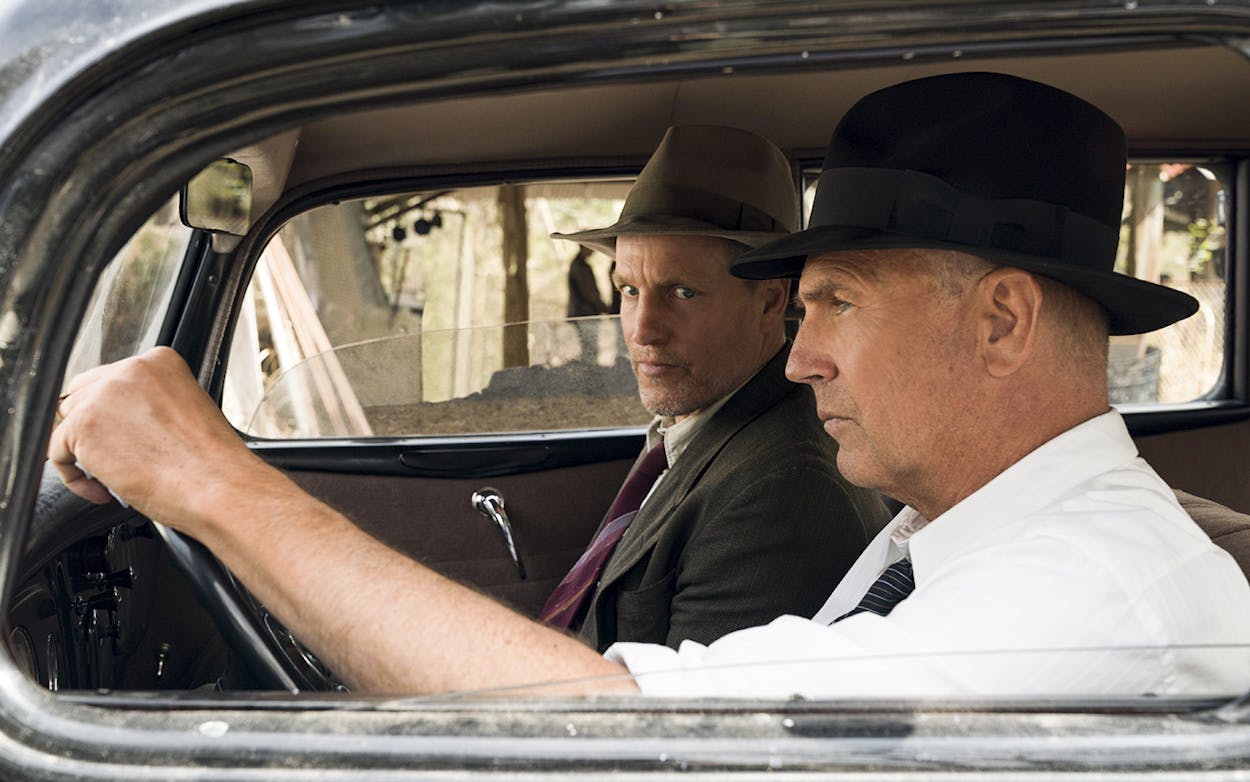To introduce the premiere of The Highwaymen at the Paramount Theater on March 10, director John Lee Hancock told a story about a movie screening in that same theater 52 years ago. In 1967, when Warren Beatty’s iconic Bonnie and Clyde came to town, Gladys Hamer bought a ticket to see what all the fuss was about. Gladys was the widow of the legendary Texas Ranger Frank Hamer, who, along with fellow Ranger Maney Gault, tracked down and killed Bonnie and Clyde in 1934. Frank Hamer, whose career in law enforcement started before the 1911 Mexican Revolution, comes off as a buffoon in the 1967 film. That didn’t sit well with Gladys, who got bulldog lawyer Joe Jamail to sue Warner Bros. for defamation of character. She won.
Hancock, a Longview native, used the anecdote to tell his audience how The Highwaymen (which will be released on Netflix on March 29) provided a different perspective on the legend of Bonnie and Clyde: this would be a classic Texas story. By the time the film introduced the character of Hamer (played by Kevin Costner) staring wistfully off into the distance on the banks of what is meant to be the Llano River, the audience was eating it up.
Unlike Bonnie and Clyde, The Highwaymen focuses on the chase from the perspective of the Rangers. It opens as law enforcement is up in arms: the Barrow gang have been wreaking havoc across the American plains for two years, amassing bodies and the admiration of the Depression-traumatized public, who hailed them as working-class heroes. Neither Hoover’s special agents nor Texas state police have been able to stop the deadly duo, so as a last-ditch effort, then-Governor Miriam ‘Ma’ Ferguson (played by Kathy Bates) begrudgingly agrees to bring in two retired Texas Rangers to get the job done: Frank Hamer and Maney Gault (Woody Harrelson).
Hamer and Gault ruffle feathers and break rules in the way only Texas Rangers can. They stockpile guns, handle evidence without wearing gloves, and cross state lines when they know they do not have any jurisdiction in Oklahoma. Throughout, they move closer to the inevitable confrontation: an encounter on a lonely stretch of Louisiana dirt road in May 1934 that will be the end of Bonnie and Clyde.
The pair loom large in the state and national imagination, and The Highwaymen bypasses familiar territory by playing with their legacy rather than telling the story straight. The film doesn’t show the faces of Bonnie and Clyde until the last fifteen minutes. Throughout, Bonnie is clad in fine silk and lace, shot from behind as she drags her burned left leg toward her next victim. Clyde wears a familiar felt fedora and often watches her from the car, his face obscured by shadow and cigarette smoke. Their vehicles gleam (despite covering the same ground, Hamer and Gault’s Ford V8 manages to get far more dusty). Bonnie and Clyde superfans appear, starstruck over seeing the folk legends in person. Hancock never shies away from the goriness of their actions (like when Bonnie rolls a police officer over with her heel so he can watch as she shoots him in the face), but the characters are just as sexy and glamorous as they were in Warren Beatty’s version.
Yet the glamour is used differently. The Bonnie and Clyde of The Highwaymen are mythical specters: beautiful and haunting, but not real. The film doesn’t care why they robbed and killed, nor what the true nature of their relationship was. (Unlike the Warren Beatty version, it offers no unsubstantiated claim that Clyde was impotent.) Instead of telling the tale of the duo, Hancock and screenwriter John Fusco question—and further—our collective fascination with them.
What makes the story of Bonnie and Clyde, and the story of the men who hunted them down, so seductive almost 85 years after their deaths? Is it the ever-familiar tropes of cops versus robbers, cowboys versus Indians? Is it the timelessness of good versus evil, made more compelling when the bad guys have goodness in them and the good guys do bad things?
And where do the Rangers fall on this spectrum? The Highwaymen treats them with sympathy, sure, and they are the film’s ultimate heroes. But they are not the objective arbiters of right and wrong. Between them, they’ve taken far more souls than Bonnie and Clyde ever did. We root for Costner’s Hamer, a hard-nosed, skillful lawman who is pathologically incapable of empathizing with criminals, but he’s not the moral heart of the film. Harrelson’s Gault is, an accomplished outlaw-hunter weighted down by the lives he’s taken.
The Highwaymen won’t revolutionize modern storytelling as Bonnie and Clyde did, but it asks thought-provoking questions—and it’s a fun watch. It’s a classic Texas story, one that doesn’t push back on the white, masculine, Wild-West mythology that Texans cling to. Watching the film with a packed audience, hundreds cheered loudly when Woody Harrelson growled, “I’m a Texas Ranger, you little shit,” before giving a bad guy a swirlee. When the Rangers cross the Red River and Woody points out that they are now in Oklahoma, a woman two seats down from me whispered, “and it still sucks.” It’s a Texas movie, and the Texans loved it. I imagine Gladys Hamer would, too.








